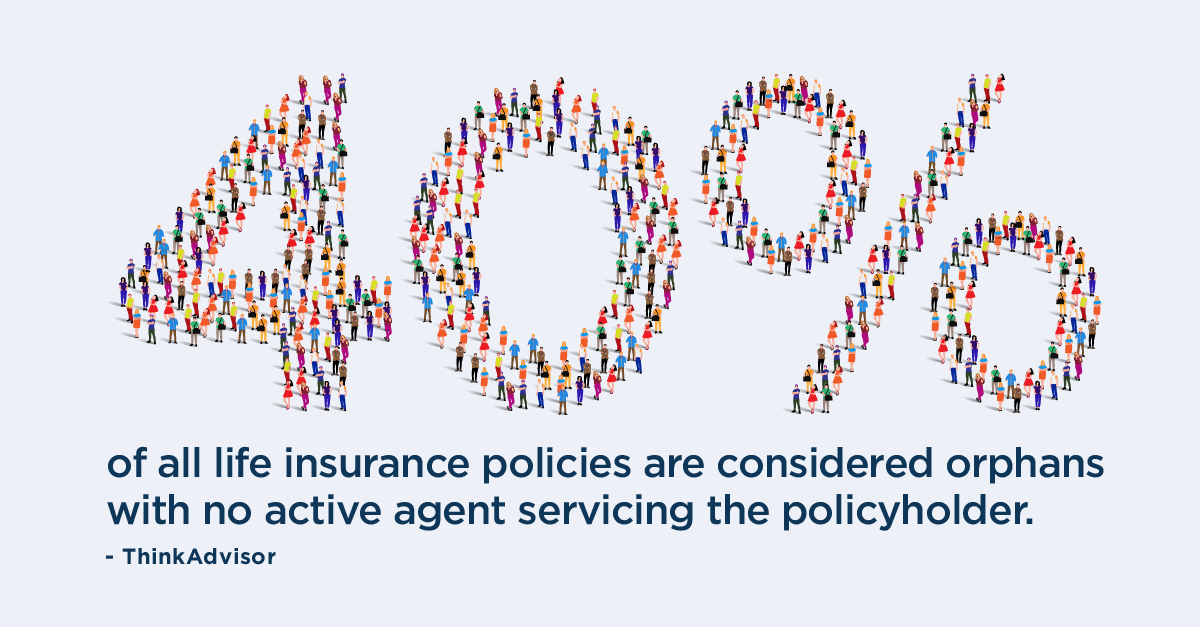In other words, life insurance customers are no longer just asking, “Will this product fit my needs?” They’re also wondering:
- “Will I be valued, considered and taken care of as a customer of this brand?”
- “In what ways will the brand prove that I’m not just another number?”
- “Will I have an enjoyable experience while applying for and buying life insurance, or will it be a hassle?”
- “Since I am buying this policy online, who do I contact if I need help?”
And for those who purchase life insurance through an agent:
- “Will my financial professional have my best interests in mind?”
Over the last few years, carriers have been answering the call. According to Forrester, “Carrier priorities stay fixed on customer loyalty… And without the ability to walk into an agency, customers—and agents—need digital tools. When we recently asked US insurance customers what attributes they value in a financial services provider, 56% said excellent customer service, 45% excellent online experiences, and 31% excellent mobile experiences.”
The work life insurance carriers are doing to create more seamless experiences has been notable, but there’s still work to be done—especially when working with individuals that, after securing coverage, are abandoned by their carrier or financial professional. As these orphaned policyholders experience life events (marriage, children, home ownership, etc.), they may require expanded coverage or other investment products offered by the carrier.
By taking care of orphaned policyholders, carriers could experience a “win-win.” Altruistically, they’d be doing the right thing for society by helping people secure more adequate coverage. And from a profitability standpoint, they’d uncover a gold mine of cross-sell and upsell opportunities.
Here’s a real-life example from someone within my network:
When I was going to school in San Diego, a good friend landed a great new job out of college. When onboarding with his employer, he attended a seminar hosted by a local financial advisor who talked about the benefits of life insurance. He didn’t know much about life insurance and never conducted serious research, but he applied after hearing the pitch and knowing it was the “adult thing to do.” After a quick application process, a printed policy arrived at his doorstep. That was the last interaction he had with his insurer for a long period of time, and the last time he heard from his financial advisor (he later found out that his advisor had struggled to establish his business and decided to pursue a career as a police officer instead).
Even after major life events—like landing a new job and getting married—he never heard from the company or any of their captive agents within his region. No suggesting a policy review, no wanting to keep in contact, no trying to build rapport. He was, as dubbed by the industry, an orphan.
In fact, the only time he did hear from that carrier was when they tried to conduct an upsell. An agent (whom he had never met) reached out; after a few sales attempts, my friend declined and hung up the phone.
Not long after, that friend took his policy elsewhere. This go around, he researched and found an advisor who took the time to coach and educate him and his wife. The advisor looked at their financial needs and recommended several solutions that made sense. And like you’d expect, he was so thrilled with his advisor and carrier that he even referred me and my wife when our needs were changing.
Policyholders (like this one) don’t plan on their carriers or financial professionals abandoning them—that’s an experience they never expect. But it is a reality for many.
If you’re an insurer, I know what you may be thinking… “Jason, we’re implementing technology and doing everything we can in order to hedge our customers from what you’re describing.” And I get that.
Regardless of how hard a carrier works to optimize the customer experience, though, some of it may be out of their control. For insurers that serve traditional distribution channels, customers often perceive their agents as an extension of the brand. This means that the interactions policyholders have with their captive or independent agent—whether positive or negative—could have a lasting effect on the customer’s perception of their insurance company.
Currently, there’s a massive population of orphaned policyholders in the industry who aren’t properly nurtured by financial professionals as their needs change. In fact, according to ThinkAdvisor, “More than 40 percent of all life insurance policies are considered orphans with no active agent servicing the policyholder.” And this group isn’t going away anytime soon—in actuality, this number could exponentially increase over the next few years. Here’s why:
-
Agents are exiting the business
The same ThinkAdvisor article highlights that one in four life insurance agents plan to retire within the next five years. With a mass agent exodus on the horizon, the number of orphaned accounts could significantly increase if well-organized succession plans and exit strategies aren’t in order.
And as retiring books of businesses are sold, it’s likely that new agents will cherry-pick the “A and B clients” and leave the “C and D clients” to be handled by carriers’ call centers. That’s an expense that carriers have been looking to control since I first got into this business 13 years ago.
-
New agent recruitment is on the decline
To make matters worse, the industry is currently undergoing an agent hiring problem. According to The Hartford’s A Generation of Leaders, only 4% of millennials are interested in or have pursued a career as an insurance advisor or agent.
It makes sense. New sales agents are hit with difficulty in the first several years of their careers. According to BetterAgency, “It takes an average insurance agent three to five years to build a book of business that can sustain a comfortable lifestyle.”
For the new agents who aren’t taking over well-established books of business, the first several years can be an uphill battle. To find a niche that can provide a sustainable living, these new agents call their list of friends and family members, host lunch seminars, buy contact lists, peruse social media, and make it awkward at their kids’ school events (I think we all forget how hard a day-in-the-life of an agent can be). When the going gets tough, or when they realize they don’t have a long-term commitment to the industry, they exit the field before they’re able to get their business off the ground—abandoning the policyholders they recruited along the way.
-
Carriers still place higher emphasis on new business
From a carrier standpoint, little priority is placed on orphaned accounts and existing books of business—the primary focus has always been new sales. In Sureify’s webinar entitled, Enlivening the Frozen Book of Business, Ann Mengelson-Clark, VP of Technology at Kuvare, touched on this, “It’s easy to focus on new sales. It’s easy to look at the shiny new thing, right? It’s what we’re used to doing, and it’s also what most of our compensation and reward structures are built around.”
Without attractive incentives that focus on cross-selling to an existing book of business, captive, independent and call center agents will naturally gravitate toward finding new sales opportunities in order to pocket higher commissions.
And just think about how much money financial professionals are spending to acquire and service that new business. Sure, technology and buying habits have changed—but fundamentally, people still enjoy being treated well and are likely to spend more money on products when they perceive value. It’s the same feeling you get when you go to your favorite restaurant and they know who you are. So why is the insurance industry so different, especially when there’s a lot more money to be made than the cost of a steak?
The truth is, there’s more value in retaining existing customers than there is in attracting new ones, and it’s key for company growth. According to Forbes, it costs five times more for life insurance and annuity carriers to attract new policyholders than it does to retain existing ones. And, according to Bain and Company, even a 5% increase in customer retention can exponentially grow a company’s profit margins by 25% to 95%.
If insurers aren’t careful, the future agent landscape—more specifically, the agent turnover policyholders will experience—could have a direct impact on carriers’ long-term business success. According to a Forrester report highlighting customer experience, one insurance company “mined over 1 million feedback records collected in Medallia over many years and connected that data to data about customers’ behaviors. The analysis showed that detractors cancel 121% more than promoters.” This statistic proves why one bad experience can result in customers jumping ship—for example, when agents exit the business and leave their policyholders “out in the cold.”
But the same report continued, stating, “Promoters have 23% higher average premium amounts than detractors, and promoters have 32% more policies than detractors.” By optimizing the customer experience to take care of orphaned policyholders, they become brand promoters… leading to higher customer lifetime value (CLV), defined by Qualtrics as “the total worth to a business of a customer over the whole period of their relationship.”
So how can insurers create customer experiences that increase retention? I think technology is the key to success.
Innovative technology and digital tools are bridging the gap for general customers. That’s a step in the right direction—but I can’t help but think that the industry can serve up better customer experiences to those with orphaned accounts. The right carrier technology could increase policyholder satisfaction and help partnering agents simultaneously. For example:
- What would happen if carriers were able to use technology to pinpoint new agents in the field and digitally share a book of business with them, full of orphaned policyholder accounts? I see the benefits for each audience: For the agent, they’re given a leg up so they can find success quickly and stay in the business. For the carrier, the agent shows loyalty and submits more business to the insurer. And for the customer, they’re no longer orphaned—they’re given a new dedicated agent that will help meet their needs over time.
- Or, what if carriers were able to provide agents with data based on service and engagement app usage? Then, agents would have the information they need in order to cross-sell policies and other services. This could be especially useful with fraternal or small niche carriers.
- And, what if carriers rethought their incentive strategy to bring orphaned and existing accounts into the fold? I think we’d see a larger focus on retention across the industry, with carriers and agents using technology to work together and cross-sell products that fit policyholders’ needs as they change.
The orphaned policyholder audience presents a huge customer retention opportunity for insurance brands, and, if engaged correctly, can be mined as an existing book of business. Here’s a deeper dive on how carriers can implement state-of-the-art technology to strategically increase retention—specifically among the orphaned account demographic:
-
Powerful data that strengthens the agent/policyholder relationship
Orphaned policyholders, just like my friend, have changing needs over time, and with digital capabilities that collect rich policyholder data, carriers and their partnering agents can properly address their needs.
Let’s say my friend’s information was collected by his carrier and, through automated technology, distributed to one of the following: 1) a regional captive agent, 2) an agent with a niche in term sales, or 3) a representative within the D2C call center. The shared customer “profile” would offer the agent robust insights that could be used to build rapport. Plus, my friend would have been more likely to engage with a dedicated agent who understood his needs. As time went on, every interaction the agent and policyholder shared would strengthen his customer experience with the brand.
Some carriers are already using this strategy to their advantage. Deloitte Insights, 2022 insurance industry outlook highlights that one insurer “utilizes an AI-powered ‘agent support system’ to better identify customers’ potential needs by analyzing internal and external data. The system has provided agents with 860,000 individuals and 80,000 corporate sales leads per month, with agent productivity increasing between 20% and 130%, compared to the conventional sales model.”
Distributors and firms are also utilizing data to enrich the sales enablement of their advisors. In fact, a report by Forrester highlighted one digital transformation that put a heavy emphasis on digitizing the advisor-investor relationship, specifically stating that: “The firm kicked off the initiative with a series of [digital tools], which helps advisors reach prospective clients.” One tool released “…aims to pair prospective clients with advisors based on preferences including location…,” while another tool “…allows clients and prospective clients to rank their priorities, which leads to deeper conversations between clients and advisors.
Evident in both examples, the companies aren’t replacing their sales force, but rather equipping them with data sets that can elevate each policyholder’s experience through human connection—something AI-powered technology will never be able to do on its own. We also see how integrating technology and capturing rich data can provide agents with stickier leads, help the carrier build retention, and ultimately, increase cross-selling opportunities.
-
Thoughtful lifecycle engagement that leads to cross-sells
Speaking of cross-selling, continuous policyholder engagement is a proven way to support additional sales. With the data my friend submitted in the application process, the carrier could have evaluated his age and placed him into a segmented marketing campaign on the topic of life insurance 101. To further promote, they could have also served up similar educational materials within a content library via a carrier-branded engagement app.Through this initial campaign and educational content, he may have shown interest in financial wellbeing. That same app could have then delivered polls, quizzes, and articles on the topic of financial wellness until new insights emerged (based on interaction) and corresponding content topics were shared automatically (and so on and so forth).
These digital touch points, paired with the annual check-ins and policy reviews from a dedicated agent, would have continuously put the insurer’s brand at the forefront of my friend’s mind—and more naturally introduced other products into the picture (i.e.: permanent insurance, home insurance, annuities, etc.) as he navigated major life events. This ongoing engagement primes conversations between policyholders and their agents, and gives agents a foot in the door when it comes to cross-selling.
-
Digital self-service tools that give control to the policyholder
When individuals become orphaned due to various factors (for instance, policyholders moving across the country, agents retiring or exiting the business, etc.) it could be beneficial to empower them to take control of their policy management so they never miss a beat. And now, fully digital self-service platforms are making it easy to give them this control.
With tools like these, insurers could have engaged with my friend often—even though he only briefly had a true local agent—by sending him push notifications and reminders to do the following: submit premium payments, update contact information, manage beneficiaries, retrieve documents, and more. And, policyholders are already used to these service-related notifications because they receive them from their banks and credit card providers on a daily basis.
These touch points are proven to build retention over time. According to a Gartner analyst report, “If customers receive value enhancement during a service interaction, they have an 82% probability of staying with that organization when presented the opportunity to switch, an 86% probability of increasing their wallet share and a 97% probability of spreading positive word of mouth.”
Orphaned accounts and existing books of business represent a large, yet underserved population of the life insurance market. And again, because it costs five times more to attract new customers than retain existing ones, carriers should seriously consider how integrating the right technology has the potential to boost these customers’ experiences and increase ROI over the long-term.
Any combination of the customer-centric approaches I mentioned above would have encouraged my friend to think, “this brand really understands my needs and cares for me as a customer.” I’m also willing to bet that, after experiencing this type of carrier engagement, he would have been much more willing to stay with the company for the long-haul, and maybe even say “yes” to an upsell or another type of product that met his needs.
And that’s the type of retention that leads to long-term business success.





